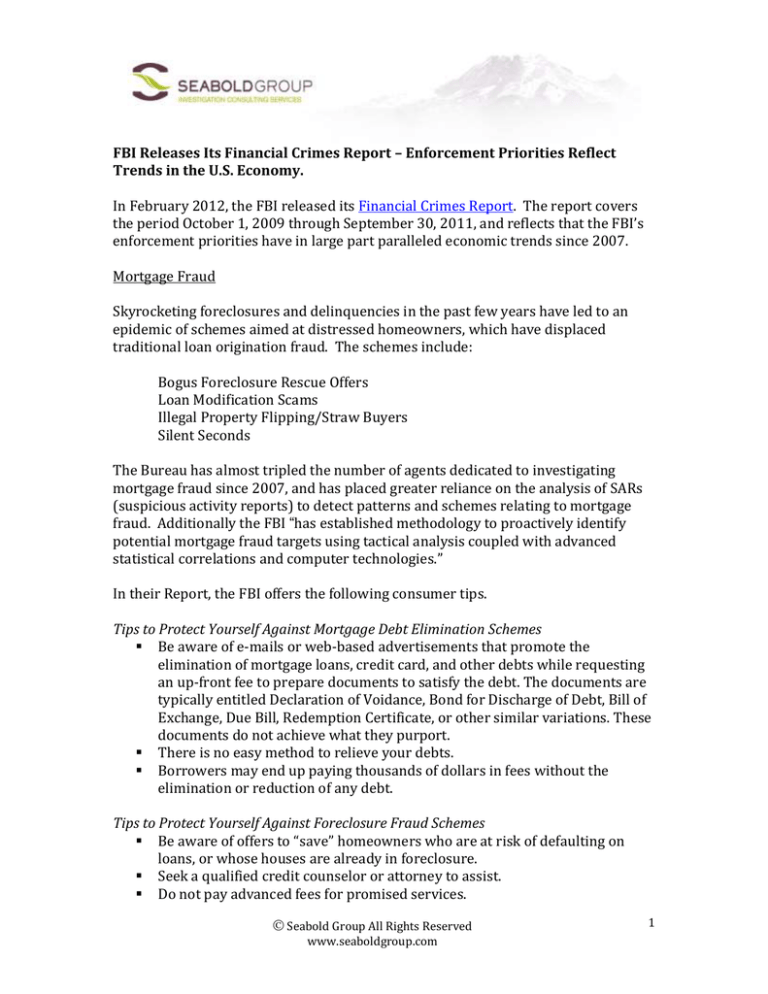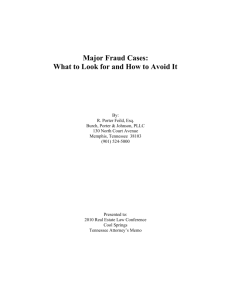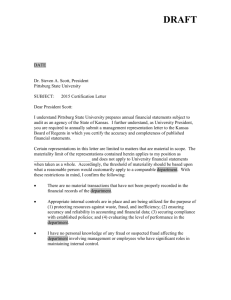
FBI Releases Its Financial Crimes Report – Enforcement Priorities Reflect
Trends in the U.S. Economy.
In February 2012, the FBI released its Financial Crimes Report. The report covers
the period October 1, 2009 through September 30, 2011, and reflects that the FBI’s
enforcement priorities have in large part paralleled economic trends since 2007.
Mortgage Fraud
Skyrocketing foreclosures and delinquencies in the past few years have led to an
epidemic of schemes aimed at distressed homeowners, which have displaced
traditional loan origination fraud. The schemes include:
Bogus Foreclosure Rescue Offers
Loan Modification Scams
Illegal Property Flipping/Straw Buyers
Silent Seconds
The Bureau has almost tripled the number of agents dedicated to investigating
mortgage fraud since 2007, and has placed greater reliance on the analysis of SARs
(suspicious activity reports) to detect patterns and schemes relating to mortgage
fraud. Additionally the FBI “has established methodology to proactively identify
potential mortgage fraud targets using tactical analysis coupled with advanced
statistical correlations and computer technologies.”
In their Report, the FBI offers the following consumer tips.
Tips to Protect Yourself Against Mortgage Debt Elimination Schemes
Be aware of e-mails or web-based advertisements that promote the
elimination of mortgage loans, credit card, and other debts while requesting
an up-front fee to prepare documents to satisfy the debt. The documents are
typically entitled Declaration of Voidance, Bond for Discharge of Debt, Bill of
Exchange, Due Bill, Redemption Certificate, or other similar variations. These
documents do not achieve what they purport.
There is no easy method to relieve your debts.
Borrowers may end up paying thousands of dollars in fees without the
elimination or reduction of any debt.
Tips to Protect Yourself Against Foreclosure Fraud Schemes
Be aware of offers to “save” homeowners who are at risk of defaulting on
loans, or whose houses are already in foreclosure.
Seek a qualified credit counselor or attorney to assist.
Do not pay advanced fees for promised services.
Seabold Group All Rights Reserved
www.seaboldgroup.com
1
Corporate Fraud
One of the FBI’s highest priorities has been the investigation of Corporate Fraud,
which includes the falsification of financial information by private and publiclytraded companies and insider trading, which has been on the rise in recent years.
One of the Bureau’s most successful prosecutions in 2011 included Raj Rajaratnam,
the founder the Galleon Group, a $7 billion hedge fund, using age-old techniques -- a
confidential informant and wire taps that produced devastating evidence against
Rajaratnam. “Mr. Rajaratnam was convicted in May 2011 by a federal jury on all 14
counts he faced pertaining to his insider trading activity and was subsequently
sentenced to 11 years’ imprisonment. “
Securities & Commodities Fraud
Securities & Commodities Fraud includes complex Ponzi schemes that have been
made so famous by the likes of Bernie Madoff and Allen Sanford. Case filings have
increased 52% since 2008 and reached their highest numbers in 2011.
The continued uncertainty and volatility of today’s financial markets could be
measured by the Dow Jones Industrial Average movement from 12,681 on
July 22, 2011, to 10,655 on October 3, 2011. As a result of such tumultuous
markets, the FBI witnessed a steady rise in securities and commodities
frauds as investors sought alternative investment opportunities. With the
development of new schemes and trends—such as securities market
manipulation via cyber intrusion, the increase in commodities fraud, the
continued rise of Ponzi schemes, and foreign-based reverse merger market
manipulation schemes—securities and commodities fraud is on the rise.
Since 2008, securities and commodities fraud investigations have increased
by 52 percent, and the FBI currently has over 1,800 pending investigations.
The FBI also has placed greater enforcement effort on detecting and prosecuting
investment fraud schemes, which usually include one or more of the following red
flags:
Offers of no- or low-risk investments
Guaranteed returns
Unusually consistent returns
The sale of unregistered securities
Complex or “secret” investment strategies
Broker embezzlement
Seabold Group All Rights Reserved
www.seaboldgroup.com
2
Unscrupulous brokers and investment advisers usually carry out these schemes.
There are, however, publically available websites that provide background
information on registered investment advisers (go to www.sec.gov) and registered
brokers and brokerage firms (go to www.finra.org), including their disciplinary
histories.
Financial Institution Fraud
Financial Institution Fraud includes “insider fraud (embezzlement and
misapplication), check fraud, counterfeit negotiable instruments, check kiting, and
fraud contributing to the failure of financial institutions.” Case filings by this Unit
steadily declined since 2007 and the Bureau conceded that as a result of the global
financial crisis and the housing crisis that started in 2007, there has been less focus
on prosecuting these types of crimes.
Health Care Fraud
Health Care Fraud will continue to consume enormous law enforcement resources
nationwide and the losses are expected to increase with health care expenditures
overall, which are estimated to increase from 14% of the GDP ($2.4 trillion) in 2011
to 19.6% of the GDP ($4.14 trillion) in 2016. The FBI reported:
All health care programs are subject to fraud; however, Medicare and
Medicaid programs are the most visible. Estimates of fraudulent billings to
health care programs, both public and private, are estimated between 3 and
10 percent of total health care expenditures. The fraud schemes are not
specific to any area, but they are found throughout the entire country. The
schemes target large health care programs, public and private, as well as
beneficiaries. Certain schemes tend to be worked more often in certain
geographical areas, and certain ethnic or national groups tend to also employ
the same fraud schemes. The fraud schemes have, over time, become more
sophisticated and complex and are now being perpetrated by more
organized crime groups.
As part of our national strategy to address HCF, the FBI cooperates with the
DOJ and the various USAOs throughout the country to pursue offenders
through parallel criminal and civil remedies. These cases typically target
large-scale medical providers, such as hospitals and corporations, who
engage in criminal activity and commit fraud against the government which
undermines the credibility of the health care system. As a result, a great deal
of emphasis is placed on recovering the illegal proceeds through seizure and
forfeiture proceedings as well as substantial civil settlements. Upon the
successful conviction of HCF offenders, the FBI provides assistance to various
Seabold Group All Rights Reserved
www.seaboldgroup.com
3
regulatory and state agencies, which may seek exclusion of convicted medical
providers from further participation in the Medicare and Medicaid health
care systems.
One of the Bureau’s most significant 2011 prosecutions in which both civil and
criminal remedies were pursued included the case against GlaxoSmithKline for the
manufacture and distribution of adulterated drugs. The government recovered
$600 million in civil fines and $150 million in criminal fines and forfeitures.
Summary
In addition to the areas above, the FBI’s report addresses their efforts and initiatives
in the areas of Insurance Fraud and Mass Marketing Fraud (Nigerian letter scams),
Money Laundering, as well as its Forensic Accountant Unit and Financial Intelligence
Center. To see the Report in its entirety go here FBI Financial Crimes Report.
Seabold Group All Rights Reserved
www.seaboldgroup.com
4






